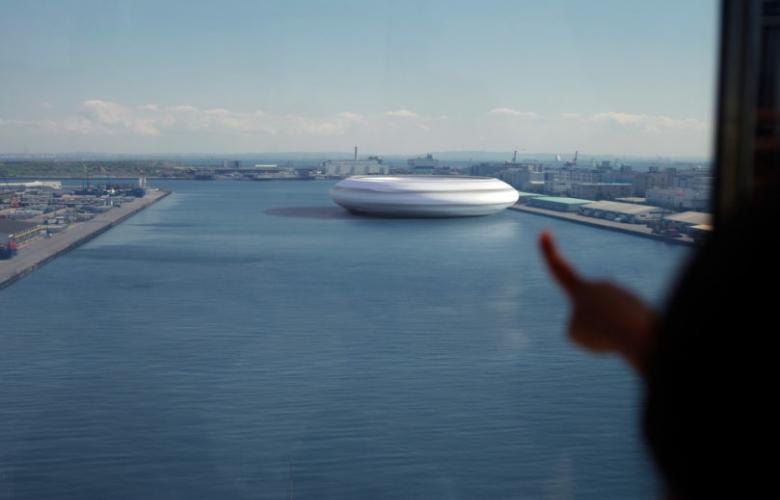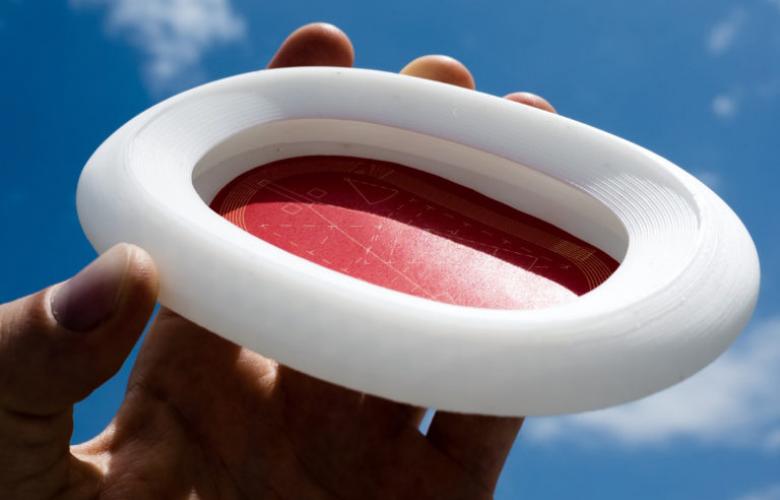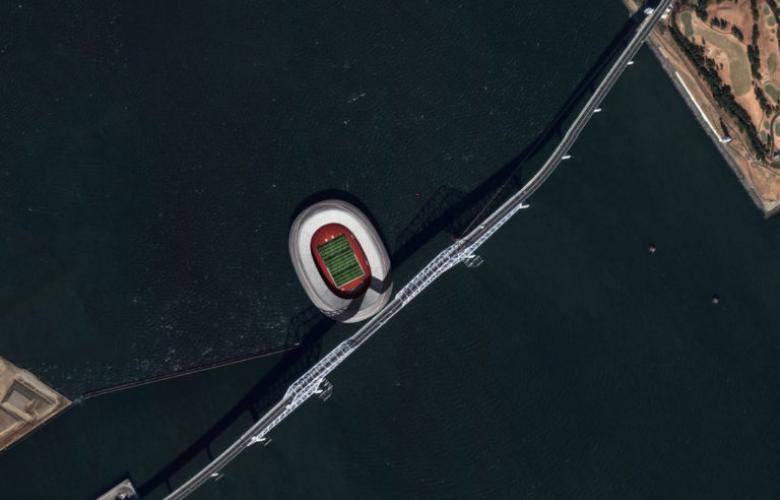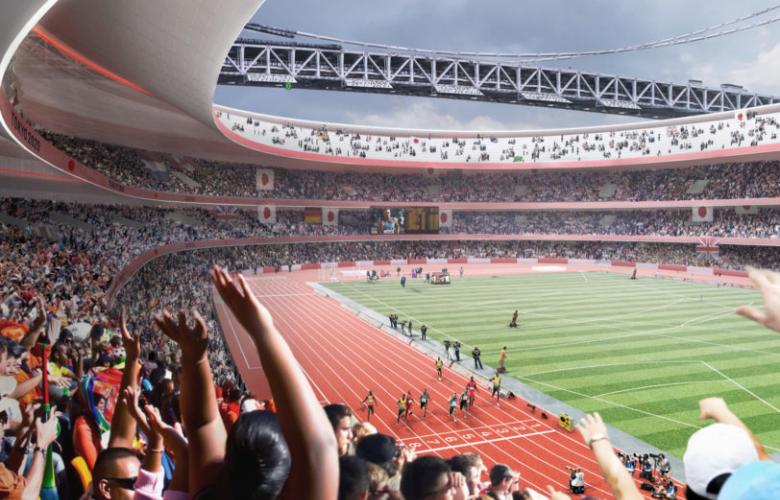Playful yet provocative, architect Florian Busch's Tokyo Olympic Odyssey project is an outspoken critique of the perceived failings of the upcoming Tokyo 2020 Olympics, but also of the attitude to architecture in Japan overall. A message from the not-so-distant future, the Odyssey is a floating stadium, an unrivaled success and an invention bound in hope and optimism.
Created in response to the controversy-rocked selection for a new Olympic stadium, the project is part-fantasy, part-reality: delivered in a black box containing a three-page letter, photographs, magazine spreads and models of the stadium. Presented as a gift from the future, the box is post-marked December 2020 and purports to portray a post-Olympics Japan, with the success of the stadium followed by its unexplained disappearance. The choice to present a future idea as a past existence gave Busch freedom:
"It allowed it to be both unmistakeably fictitious and extremely realistic at the same time. The absurdity provided the freedom to voice criticism and lay out the glaring mistakes and missed opportunities by suggesting what could have been."
In reality, having originally selected the futuristic domed design of Zaha Hadid, the Japan Sports Council later reneged on the plans, citing rising costs and public dissatisfaction. When the new finalists were unveiled, originally anonymized, the designs had similarities in structure — both used wood on an unprecedented scale — but with thematic differences. Plan A, designed by Kengo Kuma, was a space of greenery and nature, while Plan B, designed by Toyo Ito, emphasized spaces between the external structure and stands, reminiscent of the stadium being replaced. While Kengo won, and his stadium has been lauded as a good fit for the surrounding area, it has attracted some negative responses, including being nicknamed as "the hamburger" online.
It was a few days after this selection that Florian Busch created the first draft of his project, filled with incredulous disappointment that Japan had missed an opportunity to create something groundbreaking. Denouncing the "disastrous decision" of "brazen mediocrity", it may appear a bitter criticism from a loyal student of competitor Toyo Ito — but in fact, no stadium could have lived up to the possibility, thanks to the limitations placed on Japanese architecture in today's climate.
Busch states that, "Requests are unadventurous, calculable, controllable. Vision is not on the agenda. Architects are considered a risky nuisance." For a country with five times as many registered architects than America despite having only two-fifths of the population, this lack of opportunity for the creative generation of architects now and in the future is disheartening, to say the least.
"I had high hopes that Tokyo would rise to the occasion and make a case for a very different kind of Olympics. Instead everything we are seeing is nonchalant acceptance — or even a desperate clinging to — the status quo"
Travelling back in time, to the post-war Olympics in both Japan and Germany, the restorative effects of Olympic spirit have been demonstrated beyond question. Busch reflects that: "Remembering what happened in the years before and after the 1964 Olympics would make one think that Japan is one of the nations that could pull something like this off. Having to come to terms with the fact that the same nation that was able to — in an era of collective aspirations — ignite a movement, has aged into a behemoth grinding to a standstill is a cruel perspective."
The failure to combine the skills of the readily available architects and the opportunity available is a loss which will soon damage Japan, when compared to countries elsewhere. Prominent architects like Toyo Ito have successfully created groundbreaking stadiums like the eco-friendly Main Stadium for the World Games, held in Taiwan in 2009. Made from entirely sustainable materials and supporting almost 9,000 solar panels which generated an annual output of 1.14 million kilowatts, the stadium was a visionary statement of what largely temporary structures could offer beyond their simplest of functions. As architects achieve abroad what they cannot at home, it is only a matter of time before the best Japanese architects produce their best works away from home.
With limitations placed on the creative opportunity, it was not only the physical stadium which lacked vision, but the fixed belief that it needed to be created where it was, if at all.
"Out of all the gross mistakes that were made with regard to the stadium, one stood out from the beginning: the choice of the site. The only sensible response (and a very beautiful one at that) would have been to use the existing stadium. But if a new stadium was inevitable (which of course it wasn't), then surely not there?"
Rather than being focused on only modern visions of the future, the true colours of Busch's frustrations are clear: a failure by Japan to recognise the opportunity to make a statement, above all else. Be it a commentary on social, environmental or world issues, seeing the stadium as more than a show of wealth and a physical space for sports would have elevated the creation beyond a simple structure. Renovating an old stadium would have reflected the Japanese sense of mottainai (regret of waste), building a floating one could reflect a shared cultural property — whatever the message, it was the opportunity to send it that mattered most.
The selection, then, of a floating stadium, anchored below the Rainbow Bridge and then sent around the world for future games, was perhaps overly optimistic, but expressive of the potential created by the Olympics. As the accompanying three-page letter describes, it was not only an end to the "anachronistic race to outdo its predecessor", but also a boost to the entire Olympic idea as well as having a whole host of practical benefits. Shipbuilders were given work, costs would be re-couped, cool winds solved the issue of Japan's summer heat and Sendagaya ward was given a green oasis in place of a looming structure.
The transportable nature of the design is by far its most exceptional quality, and is not the first example of transience in Busch's designs. The firm's proposal for Guggenheim Museum in Helsinki has the building floating, in a buoyant state at the harbour, much like the boats which will dock beside it.
"In my work, I constantly move between stability and instability, rigid and fluid, defines and undefined, stasis and motion. As a discipline of building, architecture always tends to emphasise the former, whereas the latter is just as important, if not more so, and inarguably more intriguing. Projects like the Guggenheim Helsinki proposal are trying to question the rigid and therefore set free the full potential of a dynamic experience of space."
As a nomadic event in itself, it seems only fitting that an Olympic stadium should be a shared, transferable space; yet why is that the idea seems so unreasonable, so unrealistic? The use of stadiums as a display of wealth and success is key, as the letter states this would end the race to outdo the previous holder's bird-like mating performance. With each country determined to outdo the last, to put their own mark on the event, it seems impossible that a shared resource could ever work.
The shared nature of the stadium naturally leads to the idea of a community event, with a space designed purely for the exchange of culture and creativity. The floating stadium is a mere metaphor for the public space so often lost, and the isolation of each country's efforts which should instead be a contribution to a greater goal. When discussing whether the architecture could create bridges in our fractured world, Busch explained:
"Absolutely, this is exactly the point that the story of the floating stadium tries to put across. [...] We are witnessing a global tendency to replace public space with the insidious pseudo public space. Instead of "bridges" that connect and leave room for the unexpected and spontaneous, what you call culture-based space — in other words, space for diversity and difference — the preferred building typology today is the controllable island which can be sealed off at any time, a space of conditioned homogeneity."
By reclaiming the "island" concept and opening it up as a shared and transferable space, Busch reflects the endless opportunities that architecture can bring to seemingly solid concepts. Having chosen to deliver his critique as a creative product, he reflects this again — allowing designs to speak for the issues and potential possibilities themselves. The floating stadium is a vehicle, in a dual sense, as it exists to promote movement and shared experience, but is also a vehicle for Busch's criticisms of the process, packaged and presented as a fun, futuristic idea. While he acknowledges that "the impact of the Olympic buildings is just a small drop in the continuously flowing river that is Tokyo, which, of course, does not mitigate the fact that it is a blatant loss of opportunity," it seems that this, more than anything, means it is surely a risk worth taking.
Read here for more on Florian Busch's Tokyo Olympic Odyssey project.
By Lily Crossley-Baxter
Similar to this:
Yokohama Apartment: A unique city residency space in Japan
Technology, text and tradition: The architectural wonders of Japan's modern libraries
Out with the old, in with the new: Why older buildings are unpopular in Japan








